check engine PONTIAC VIBE 2010 Owner's Guide
[x] Cancel search | Manufacturer: PONTIAC, Model Year: 2010, Model line: VIBE, Model: PONTIAC VIBE 2010Pages: 318, PDF Size: 1.7 MB
Page 255 of 318
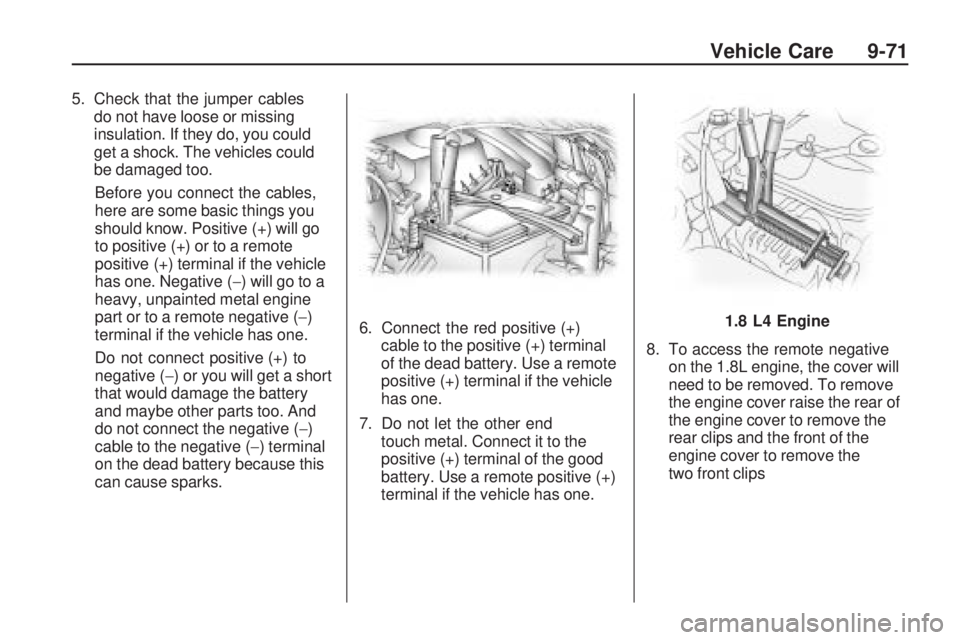
5. Check that the jumper cablesdo not have loose or missing
insulation. If they do, you could
get a shock. The vehicles could
be damaged too.
Before you connect the cables,
here are some basic things you
should know. Positive (+) will go
to positive (+) or to a remote
positive (+) terminal if the vehicle
has one. Negative (−) will go to a
heavy, unpainted metal engine
part or to a remote negative (−)
terminal if the vehicle has one.
Do not connect positive (+) to
negative (−) or you will get a short
that would damage the battery
and maybe other parts too. And
do not connect the negative ( −)
cable to the negative (−) terminal
on the dead battery because this
can cause sparks. 6. Connect the red positive (+)
cable to the positive (+) terminal
of the dead battery. Use a remote
positive (+) terminal if the vehicle
has one.
7. Do not let the other end touch metal. Connect it to the
positive (+) terminal of the good
battery. Use a remote positive (+)
terminal if the vehicle has one. 8. To access the remote negative
on the 1.8L engine, the cover will
need to be removed. To remove
the engine cover raise the rear of
the engine cover to remove the
rear clips and the front of the
engine cover to remove the
two front clips
1.8 L4 Engine
Vehicle Care 9-71
Page 269 of 318
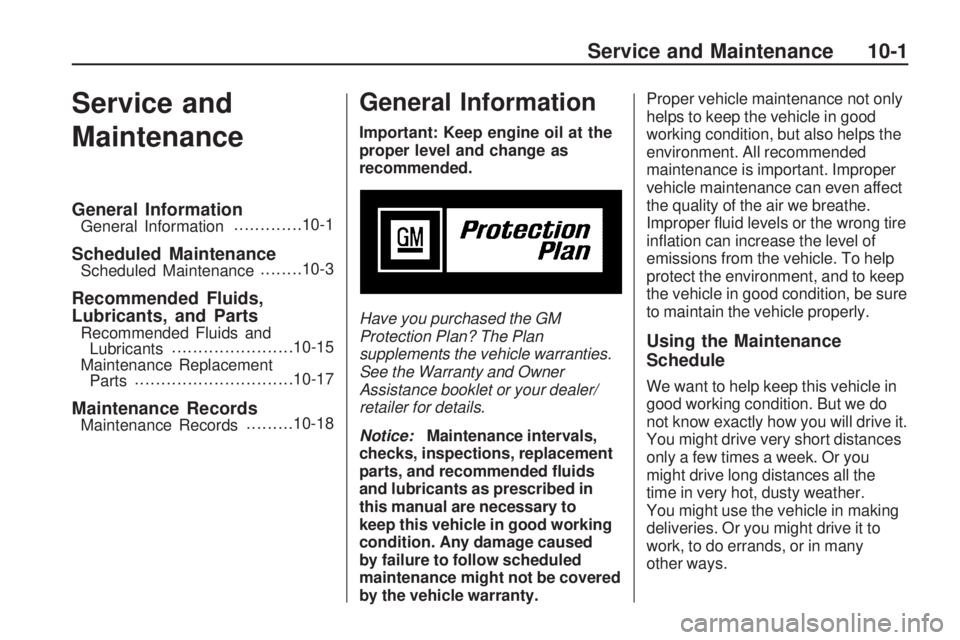
Service and
Maintenance
General InformationGeneral Information.............10-1
Scheduled MaintenanceScheduled Maintenance ........10-3
Recommended Fluids,
Lubricants, and Parts
Recommended Fluids and
Lubricants ......................
.10-15
Maintenance Replacement Parts .............................
.10-17
Maintenance RecordsMaintenance Records .........10-18
General Information
Important: Keep engine oil at the
proper level and change as
recommended.
Have you purchased the GM
Protection Plan? The Plan
supplements the vehicle warranties.
See the Warranty and Owner
Assistance booklet or your dealer/
retailer for details.
Notice:
Maintenance intervals,
checks, inspections, replacement
parts, and recommended �uids
and lubricants as prescribed in
this manual are necessary to
keep this vehicle in good working
condition. Any damage caused
by failure to follow scheduled
maintenance might not be covered
by the vehicle warranty. Proper vehicle maintenance not only
helps to keep the vehicle in good
working condition, but also helps the
environment. All recommended
maintenance is important. Improper
vehicle maintenance can even affect
the quality of the air we breathe.
Improper fluid levels or the wrong tire
inflation can increase the level of
emissions from the vehicle. To help
protect the environment, and to keep
the vehicle in good condition, be sure
to maintain the vehicle properly.
Using the Maintenance
Schedule
We want to help keep this vehicle in
good working condition. But we do
not know exactly how you will drive it.
You might drive very short distances
only a few times a week. Or you
might drive long distances all the
time in very hot, dusty weather.
You might use the vehicle in making
deliveries. Or you might drive it to
work, to do errands, or in many
other ways.
Service and Maintenance 10-1
Page 271 of 318
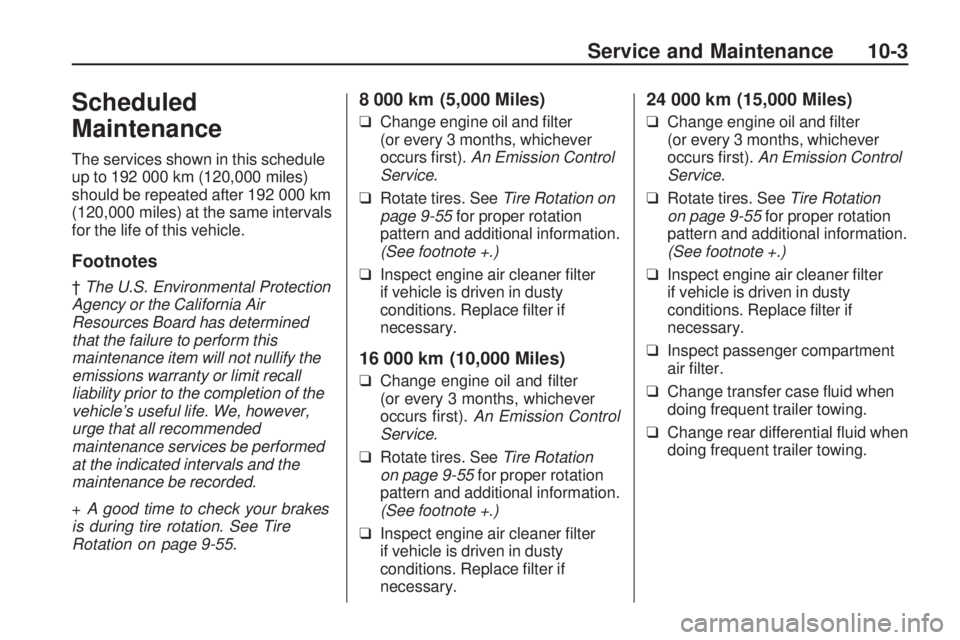
Scheduled
Maintenance
The services shown in this schedule
up to 192 000 km (120,000 miles)
should be repeated after 192 000 km
(120,000 miles) at the same intervals
for the life of this vehicle.
Footnotes
†The U.S. Environmental Protection
Agency or the California Air
Resources Board has determined
that the failure to perform this
maintenance item will not nullify the
emissions warranty or limit recall
liability prior to the completion of the
vehicle’s useful life. We, however,
urge that all recommended
maintenance services be performed
at the indicated intervals and the
maintenance be recorded.
+ A good time to check your brakes
is during tire rotation. See Tire
Rotation on page 9-55 .
8 000 km (5,000 Miles)
❑Change engine oil and filter
(or every 3 months, whichever
occurs first). An Emission Control
Service.
❑ Rotate tires. See Tire Rotation on
page 9-55 for proper rotation
pattern and additional information.
(See footnote +.)
❑ Inspect engine air cleaner filter
if vehicle is driven in dusty
conditions. Replace filter if
necessary.
16 000 km (10,000 Miles)
❑ Change engine oil and filter
(or every 3 months, whichever
occurs first). An Emission Control
Service.
❑ Rotate tires. See Tire Rotation
on page 9-55 for proper rotation
pattern and additional information.
(See footnote +.)
❑ Inspect engine air cleaner filter
if vehicle is driven in dusty
conditions. Replace filter if
necessary.
24 000 km (15,000 Miles)
❑ Change engine oil and filter
(or every 3 months, whichever
occurs first). An Emission Control
Service.
❑ Rotate tires. See Tire Rotation
on page 9-55 for proper rotation
pattern and additional information.
(See footnote +.)
❑ Inspect engine air cleaner filter
if vehicle is driven in dusty
conditions. Replace filter if
necessary.
❑ Inspect passenger compartment
air filter.
❑ Change transfer case fluid when
doing frequent trailer towing.
❑ Change rear differential fluid when
doing frequent trailer towing.
Service and Maintenance 10-3
Page 272 of 318
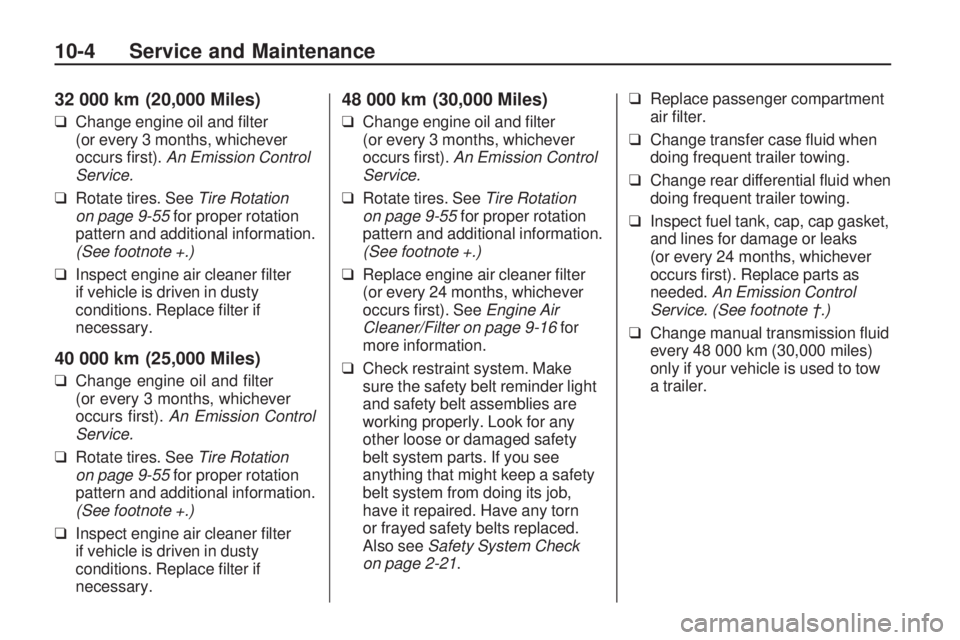
32 000 km (20,000 Miles)
❑Change engine oil and filter
(or every 3 months, whichever
occurs first). An Emission Control
Service.
❑ Rotate tires. See Tire Rotation
on page 9-55 for proper rotation
pattern and additional information.
(See footnote +.)
❑ Inspect engine air cleaner filter
if vehicle is driven in dusty
conditions. Replace filter if
necessary.
40 000 km (25,000 Miles)
❑ Change engine oil and filter
(or every 3 months, whichever
occurs first). An Emission Control
Service.
❑ Rotate tires. See Tire Rotation
on page 9-55 for proper rotation
pattern and additional information.
(See footnote +.)
❑ Inspect engine air cleaner filter
if vehicle is driven in dusty
conditions. Replace filter if
necessary.
48 000 km (30,000 Miles)
❑ Change engine oil and filter
(or every 3 months, whichever
occurs first). An Emission Control
Service.
❑ Rotate tires. See Tire Rotation
on page 9-55 for proper rotation
pattern and additional information.
(See footnote +.)
❑ Replace engine air cleaner filter
(or every 24 months, whichever
occurs first). See Engine Air
Cleaner/Filter on page 9-16 for
more information.
❑ Check restraint system. Make
sure the safety belt reminder light
and safety belt assemblies are
working properly. Look for any
other loose or damaged safety
belt system parts. If you see
anything that might keep a safety
belt system from doing its job,
have it repaired. Have any torn
or frayed safety belts replaced.
Also see Safety System Check
on page 2-21. ❑
Replace passenger compartment
air filter.
❑ Change transfer case fluid when
doing frequent trailer towing.
❑ Change rear differential fluid when
doing frequent trailer towing.
❑ Inspect fuel tank, cap, cap gasket,
and lines for damage or leaks
(or every 24 months, whichever
occurs first). Replace parts as
needed. An Emission Control
Service. (See footnote †.)
❑ Change manual transmission fluid
every 48 000 km (30,000 miles)
only if your vehicle is used to tow
a trailer.
10-4 Service and Maintenance
Page 274 of 318

96 000 km (60,000 Miles)
❑Change engine oil and filter
(or every 3 months, whichever
occurs first). An Emission Control
Service.
❑ Rotate tires. See Tire Rotation
on page 9-55 for proper rotation
pattern and additional
information. (See footnote +.)
❑ Replace engine air cleaner filter
(or every 24 months, whichever
occurs first). See Engine Air
Cleaner/Filter on page 9-16 for
more information.
❑ Check restraint system. Make
sure the safety belt reminder light
and safety belt assemblies are
working properly. Look for any
other loose or damaged safety
belt system parts. If you see
anything that might keep a safety
belt system from doing its job,
have it repaired. Have any torn
or frayed safety belts replaced.
Also see Safety System Check
on page 2-21. ❑
Replace passenger compartment
air filter.
❑ Change transfer case fluid when
doing frequent trailer towing.
❑ Change rear differential fluid when
doing frequent trailer towing.
❑ Inspect engine accessory drive
belts (or every 48 months,
whichever occurs first). Visually
inspect belt for fraying, excessive
cracks, or obvious damage.
Replace belt if necessary.
An Emission Control Service.
❑ Inspect for tappet noise and
engine vibration. Adjust valve
clearance to factory specifications
if necessary (or every 48 months,
whichever occurs first). An
Emission Control Service.
❑ Inspect fuel tank, cap, cap gasket,
and lines for damage or leaks
(or every 24 months, whichever
occurs first). Replace parts as
needed. An Emission Control
Service. (See footnote †.) ❑
Change manual transmission fluid
every 48 000 km (30,000 miles)
only if your vehicle is used to tow
a trailer.
❑ Change automatic
transmission fluid every
96 000 km (60,000 miles) if the
vehicle is mainly driven under one
or more of these conditions:
- In heavy city traffic where the outside temperature regularly
reaches 32°C (90°F) or higher.
- In hilly or mountainous terrain.
- When doing frequent trailer towing.
- Uses such as found in taxi, police, or delivery service.
If you do not use your vehicle under
any of these conditions, the �uid
does not require changing.
See Recommended Fluids and
Lubricants on page 10-15 for
the proper �uid to use.
10-6 Service and Maintenance
Page 276 of 318

144 000 km (90,000 Miles)
❑Change engine oil and filter
(or every 3 months, whichever
occurs first). An Emission Control
Service.
❑ Rotate tires. See Tire Rotation
on page 9-55 for proper rotation
pattern and additional
information. (See footnote +.)
❑ Replace engine air cleaner filter
(or every 24 months, whichever
occurs first). See Engine Air
Cleaner/Filter on page 9-16 for
more information.
❑ Check restraint system. Make
sure the safety belt reminder light
and safety belt assemblies are
working properly. Look for any
other loose or damaged safety
belt system parts. If you see
anything that might keep a safety
belt system from doing its job,
have it repaired. Have any torn
or frayed safety belts replaced.
Also see Safety System Check
on page 2-21. ❑
Replace passenger compartment
air filter.
❑ Change transfer case fluid when
doing frequent trailer towing.
❑ Change rear differential fluid when
doing frequent trailer towing.
❑ Inspect engine accessory drive
belts (or 12 months since last
inspection). An Emission Control
Service.
❑ Inspect fuel tank, cap, cap gasket,
and lines for damage or leaks
(or every 24 months, whichever
occurs first). Replace parts as
needed. An Emission Control
Service. (See footnote †.)
❑ Change manual transmission fluid
every 48 000 km (30,000 miles)
only if your vehicle is used to tow
a trailer.
152 000 km (95,000 Miles)
❑ Change engine oil and filter
(or every 3 months, whichever
occurs first). An Emission Control
Service.
❑ Rotate tires. See Tire Rotation
on page 9-55 for proper rotation
pattern and additional information.
(See footnote +.)
❑ Inspect engine air cleaner filter
if vehicle is driven in dusty
conditions. Replace filter if
necessary.
160 000 km (100,000 Miles)
❑ Change engine oil and filter
(or every 3 months, whichever
occurs first). An Emission Control
Service.
❑ Rotate tires. See Tire Rotation
on page 9-55 for proper rotation
pattern and additional information.
(See footnote +.)
❑ Inspect engine air cleaner filter
if vehicle is driven in dusty
conditions. Replace filter if
necessary.
10-8 Service and Maintenance
Page 279 of 318
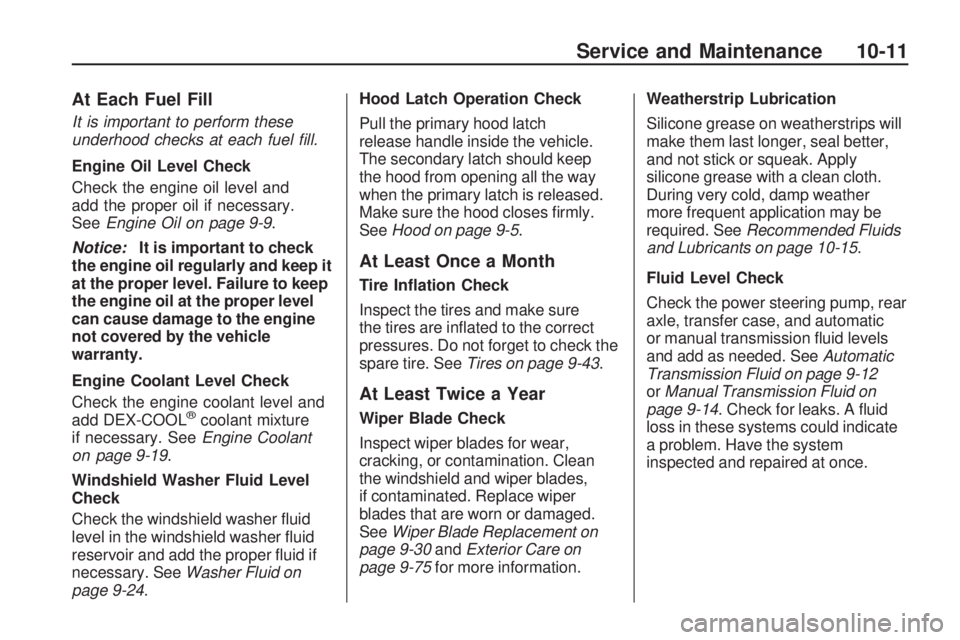
At Each Fuel Fill
It is important to perform these
underhood checks at each fuel �ll.
Engine Oil Level Check
Check the engine oil level and
add the proper oil if necessary.
SeeEngine Oil on page 9-9 .
Notice: It is important to check
the engine oil regularly and keep it
at the proper level. Failure to keep
the engine oil at the proper level
can cause damage to the engine
not covered by the vehicle
warranty.
Engine Coolant Level Check
Check the engine coolant level and
add DEX-COOL
®coolant mixture
if necessary. See Engine Coolant
on page 9-19.
Windshield Washer Fluid Level
Check
Check the windshield washer fluid
level in the windshield washer fluid
reservoir and add the proper fluid if
necessary. See Washer Fluid on
page 9-24. Hood Latch Operation Check
Pull the primary hood latch
release handle inside the vehicle.
The secondary latch should keep
the hood from opening all the way
when the primary latch is released.
Make sure the hood closes firmly.
See
Hood on page 9-5.
At Least Once a Month
Tire In�ation Check
Inspect the tires and make sure
the tires are inflated to the correct
pressures. Do not forget to check the
spare tire. See Tires on page 9-43.
At Least Twice a Year
Wiper Blade Check
Inspect wiper blades for wear,
cracking, or contamination. Clean
the windshield and wiper blades,
if contaminated. Replace wiper
blades that are worn or damaged.
SeeWiper Blade Replacement on
page 9-30 andExterior Care on
page 9-75 for more information. Weatherstrip Lubrication
Silicone grease on weatherstrips will
make them last longer, seal better,
and not stick or squeak. Apply
silicone grease with a clean cloth.
During very cold, damp weather
more frequent application may be
required. See
Recommended Fluids
and Lubricants on page 10-15 .
Fluid Level Check
Check the power steering pump, rear
axle, transfer case, and automatic
or manual transmission fluid levels
and add as needed. See Automatic
Transmission Fluid on page 9-12
or Manual Transmission Fluid on
page 9-14. Check for leaks. A fluid
loss in these systems could indicate
a problem. Have the system
inspected and repaired at once.
Service and Maintenance 10-11
Page 280 of 318
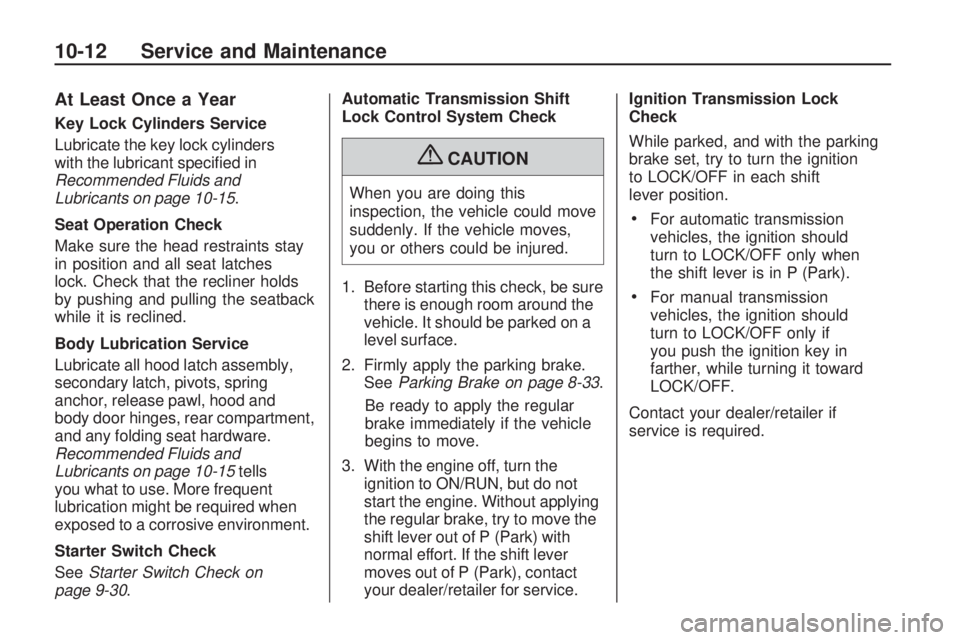
At Least Once a Year
Key Lock Cylinders Service
Lubricate the key lock cylinders
with the lubricant specified in
Recommended Fluids and
Lubricants on page 10-15.
Seat Operation Check
Make sure the head restraints stay
in position and all seat latches
lock. Check that the recliner holds
by pushing and pulling the seatback
while it is reclined.
Body Lubrication Service
Lubricate all hood latch assembly,
secondary latch, pivots, spring
anchor, release pawl, hood and
body door hinges, rear compartment,
and any folding seat hardware.
Recommended Fluids and
Lubricants on page 10-15 tells
you what to use. More frequent
lubrication might be required when
exposed to a corrosive environment.
Starter Switch Check
See Starter Switch Check on
page 9-30. Automatic Transmission Shift
Lock Control System Check
{CAUTION
When you are doing this
inspection, the vehicle could move
suddenly. If the vehicle moves,
you or others could be injured.
1. Before starting this check, be sure there is enough room around the
vehicle. It should be parked on a
level surface.
2. Firmly apply the parking brake. See Parking Brake on page 8-33 .
Be ready to apply the regular
brake immediately if the vehicle
begins to move.
3. With the engine off, turn the ignition to ON/RUN, but do not
start the engine. Without applying
the regular brake, try to move the
shift lever out of P (Park) with
normal effort. If the shift lever
moves out of P (Park), contact
your dealer/retailer for service. Ignition Transmission Lock
Check
While parked, and with the parking
brake set, try to turn the ignition
to LOCK/OFF in each shift
lever position.
•For automatic transmission
vehicles, the ignition should
turn to LOCK/OFF only when
the shift lever is in P (Park).
•For manual transmission
vehicles, the ignition should
turn to LOCK/OFF only if
you push the ignition key in
farther, while turning it toward
LOCK/OFF.
Contact your dealer/retailer if
service is required.
10-12 Service and Maintenance
Page 281 of 318
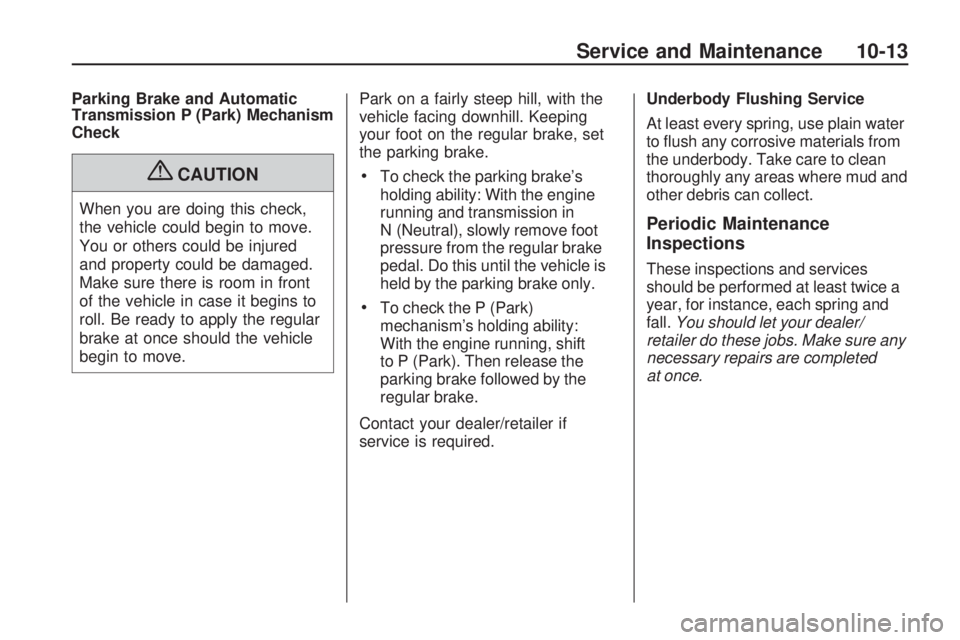
Parking Brake and Automatic
Transmission P (Park) Mechanism
Check
{CAUTION
When you are doing this check,
the vehicle could begin to move.
You or others could be injured
and property could be damaged.
Make sure there is room in front
of the vehicle in case it begins to
roll. Be ready to apply the regular
brake at once should the vehicle
begin to move.Park on a fairly steep hill, with the
vehicle facing downhill. Keeping
your foot on the regular brake, set
the parking brake.
•To check the parking brake’s
holding ability: With the engine
running and transmission in
N (Neutral), slowly remove foot
pressure from the regular brake
pedal. Do this until the vehicle is
held by the parking brake only.
•To check the P (Park)
mechanism’s holding ability:
With the engine running, shift
to P (Park). Then release the
parking brake followed by the
regular brake.
Contact your dealer/retailer if
service is required. Underbody Flushing Service
At least every spring, use plain water
to flush any corrosive materials from
the underbody. Take care to clean
thoroughly any areas where mud and
other debris can collect.
Periodic Maintenance
Inspections
These inspections and services
should be performed at least twice a
year, for instance, each spring and
fall.
You should let your dealer/
retailer do these jobs. Make sure any
necessary repairs are completed
at once.
Service and Maintenance 10-13
Page 309 of 318

A
Accessories andModifications ...................... 9-3
Accessory Power .................8-18
Adding Equipment to the Airbag-Equipped Vehicle ....2-35
Add-On Electrical Equipment ....................... 8-50
Adjustments Seat, Front ........................ 2-4
Seat, Initial Drive ................ 2-3
Air Cleaner/Filter, Engine .......9-16
Air Filter, Passenger Compartment ..................... 7-4
Air Vents .............................. 7-4
Airbag System Check ............................. 2-36
How Does an Airbag Restrain? ..................... 2-28
Passenger Sensing System ........................ 2-29
What Makes an Airbag Inflate? ........................ 2-27Airbag System (cont.)
What Will You See Afteran Airbag Inflates? ........2-28
When Should an Airbag Inflate? ........................ 2-26
Where Are the Airbags? .....2-24
Airbags Adding Equipment to theVehicle ........................ 2-35
Passenger Status Indicator ....................... 4-13
Readiness Light ................4-12
Servicing Airbag-Equipped Vehicles ....................... 2-34
System Check ..................2-23
Alarm System Anti-Theft .......................... 1-7
All-Wheel Drive ............8-31, 9-29
All-Wheel-Drive Service Light ............................... 4-18
AM-FM Radio ........................ 6-4
Antenna Satellite Radio ................... 6-9
Antilock Brake System (ABS) ..................8-32
Warning Light ................... 4-17Anti-Theft
Alarm System .................... 1-7
Appearance Care Exterior ........................... 9-75
Interior ............................ 9-80
Ashtrays ...............................
4-8
Assistance Program, Roadside ......................... 12-6
Audio Players ........................ 6-9
CD ................................... 6-9
MP3 ............................... 6-11
Audio System Fixed Mast Antenna ............ 6-8
Audio Systems Radio Reception ................. 6-8
Automatic Headlamp System .............. 5-3
Automatic Transmission ............8-24, 8-27
Fluid ............................... 9-12
Manual Mode ................... 8-28
Auxiliary Devices ..................6-14
INDEX i-1